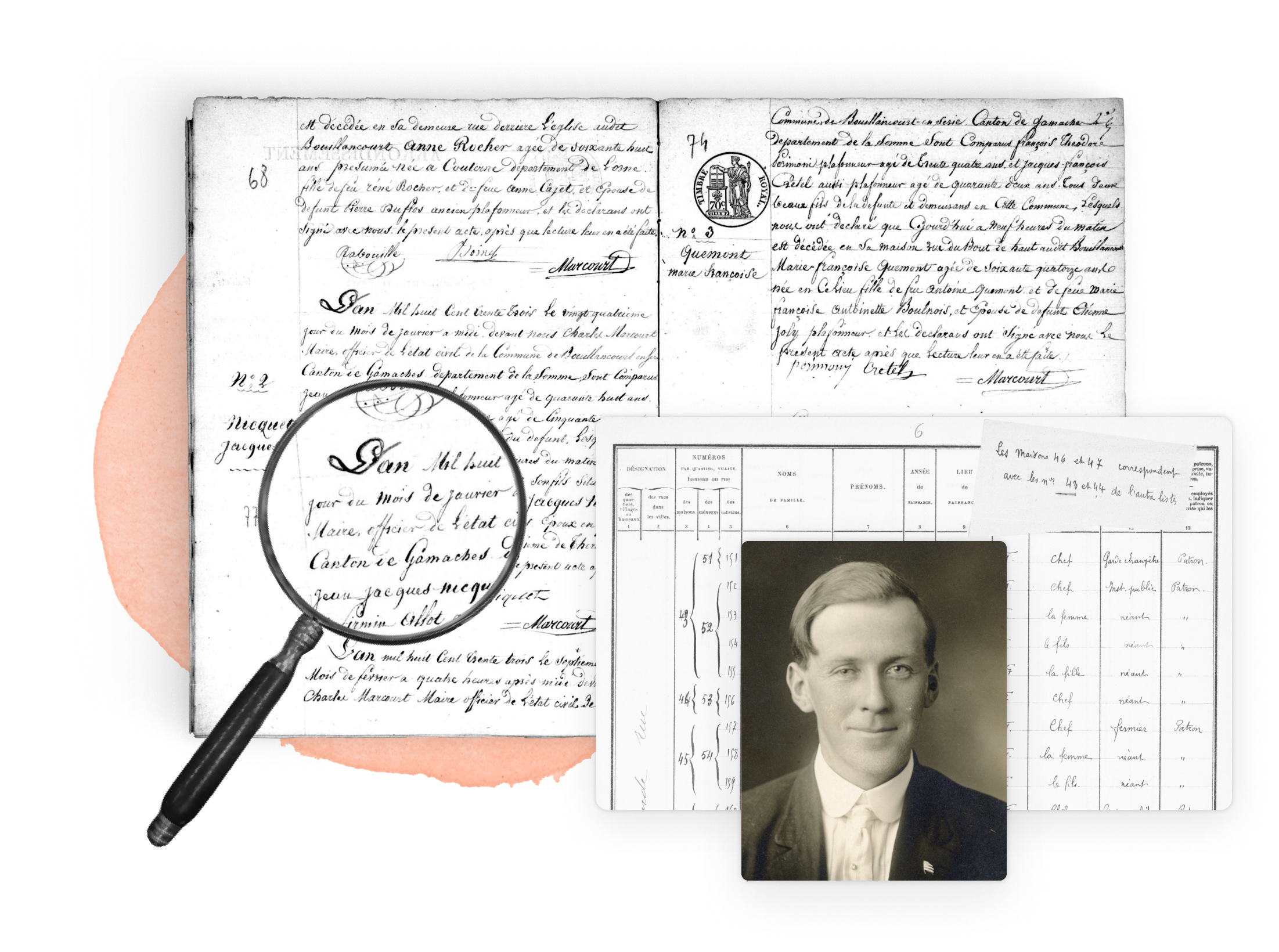Irish military records are records relating to the various armed services and military units which have operated in Ireland over the centuries. Since 1924, in the aftermath of the establishment of the Irish Free State, this has primarily related to the Irish Defence Forces, which were established that year. Because Ireland is split into two countries, with Northern Ireland still being a part of the United Kingdom, and also because of the civil conflict there between the 1960s and the 1990s, several different British armed forces served there in the twentieth century. Prior to the independence of Ireland, various iterations of English and British militaries were active in Ireland. This complicated history has resulted in various records pertaining to military forces in Ireland being found in archives in both Ireland and the United Kingdom today.[1]
Research your ancestors on MyHeritage
History of military forces in Ireland

The first military activity that we have records for in Ireland is found in the Gaelic annals, a series of lengthy annalistic histories combined for the late medieval and early modern periods. These provided records going back to late antiquity and constitute some of the most extensive annalistic histories ever kept anywhere in the world.[1] They are, though, of little utility in tracing a person’s genealogy unless their forebears were kings of one of the great Irish lordships. Instead we have to come forward to the late medieval period in the fourteenth and fifteenth centuries before we find more practical military records. By that time the English conquest of Ireland was already underway and had been in piecemeal fashion since the early 1170s. It was finally completed in the sixteenth and seventeenth centuries when England, as a centralizing Renaissance state, was able to deploy ever greater resources and better military technology against the divided Irish lordships. By the end of the reign of Queen Elizabeth I in 1603 the island had largely been pacified at the end of the Nine Years’ War.[2]
The Tudor conquest of Ireland did not lead to a steep decline in military activity in Ireland. The island proved to be one of the few corners of its empire where British ingenuity simply failed to pacify the local population. Huge wars wracked the country in the 1640s and again in the early 1690s, though both were defeated and led to ever greater land confiscations and plantations by British Protestants.[3] In the eighteenth century the Irish turned to agrarian terrorism in order to resist British rule, followed by a number of serious new revolts from 1798 onwards into the nineteenth century.[4]
From the 1830s onwards Irish statesmen turned to constitutional reform as the means of enfranchising Irish Catholics and reversing the country’s dreadful poverty, but when the British political establishment failed to deliver Home Rule which would restore an Irish parliament in the early twentieth century, a new revolt, known as the Easter Rising, occurred in 1916 in the midst of the First World War, followed by a War of Independence between 1919 and 1921. The latter conflict finally led to Irish independence, only for a civil war to ensue over the terms of that independence.[5] One of the points of contention was the creation of a Protestant-dominated Northern Ireland in Ulster. A terrorist campaign led by the Irish Republican Army on behalf of the rights of northern Catholics made Northern Ireland one of the most dangerous places in Europe between the 1960s and 1990s. Armies and conflict have been central to Irish history.[6]
Where to find Irish military forces
Records relating to the Irish Defence Forces or British armed forces in Northern Ireland in modern times are relatively easy to locate. Those pertaining to the Irish Defence Forces are held at their Military Archives, which also hold some other records of interest.[7] The records of British armed forces in Northern Ireland are managed by the UK government, though owing to the sensitive nature of the Troubles in Northern Ireland between the 1960s and the 1990s and still unresolved legal issues concerning military activity there, many of these records are restricted.

For the history of the British army in Ireland between the Act of Union in 1800 (through which the Irish parliament was dissolved and Great Britain became the United Kingdom) and the establishment of the Irish Free State in 1922, the bulk of the relevant records are held at the National Archives of the United Kingdom at Kew in London. Many of these records were being kept in a more systematic fashion from the mid-eighteenth century onwards.[8] Many of these records, notably militia records for the late nineteenth and early twentieth centuries, and Irish service records within the wider British war effort during the First World War, are available to consult through MyHeritage.
Prior to the nineteenth century, records relating to English and subsequently British forces in Ireland between the sixteenth and eighteenth centuries are generally dispersed throughout the wider State Papers Ireland Series. Here a diligent researcher will find things like army establishment listings that give the names of captains of units in Ireland, lists of soldiers who were cashiered (disbanded), officers who received pensions for their service and full accounts of the army establishment made up by auditors or the Irish treasurer. Generally, these records are only of use for tracing individuals who were captains or officers of one kind or another, though many of the names that turn up are interesting and include figures like Sir Walter Raleigh. Ordinary rank and file soldiers are typically not listed in the sixteenth and seventeenth centuries, though they may have been mentioned here and there in the voluminous correspondence relating to Ireland’s many wars during these centuries.[9] The originals of the State Papers Ireland are housed in the National Archives of the United Kingdom, though the entire collection has been digitized in recent times by Gale Cengage and is available through State Papers Online on an institutional level.[10]
What can be found in Irish military records
The kind of information that will be found in Irish military records will vary greatly depending on where and when they were produced. For instance, more modern records pertaining to the Irish Defence Forces will constitute a systematic service record with biographical details and accounts of where a soldier was stationed or deployed over time.[11] Conversely, a military record relating to an English officer in Ireland in the sixteenth century might reveal only that the man was stationed in a fort in Munster during the Desmond Rebellion of 1579 to 1583 or passed through Dublin during the Nine Years War, c. 1593–1603. The detail can vary considerably and becomes more unpredictable the further one goes back in time.[12]
See also
Explore more about Irish military records
- British Militia Attestations Index, 1886-1910 records collection on MyHeritage
- British Militia Attestations Index, Royal Garrison Artillery, 1872-1915 records collection on MyHeritage
- Ireland's Memorial Records, 1914-1918 records collection on MyHeritage
- Finding Evidence of Kinship in Military Records at Legacy Family Tree Webinars
References
- ↑ John P. Duggan, A History of the Irish Army (Dublin, 1991).
- ↑ John McGurk, The Elizabethan Conquest of Ireland (New York, 1997).
- ↑ https://www.historyireland.com/the-williamite-war-1689-9111/
- ↑ https://www.nam.ac.uk/explore/irish-rebellion-1798
- ↑ https://www.nam.ac.uk/explore/irish-war-independence
- ↑ https://www.nam.ac.uk/explore/troubles-1969-2007
- ↑ https://www.militaryarchives.ie/home
- ↑ https://www.nationalarchives.gov.uk/help-with-your-research/research-guides/british-army-soldiers-up-to-1913/
- ↑ https://www.nationalarchives.gov.uk/help-with-your-research/research-guides/state-papers-ireland-1509-1782/
- ↑ https://www.gale.com/intl/primary-sources/state-papers-online-early-modern
- ↑ https://www.militaryarchives.ie/genealogy
- ↑ James O’Neill, The Nine Years War, 1593–1603: Tyrone, Mountjoy and the Military Revolution (Dublin, 2016).


